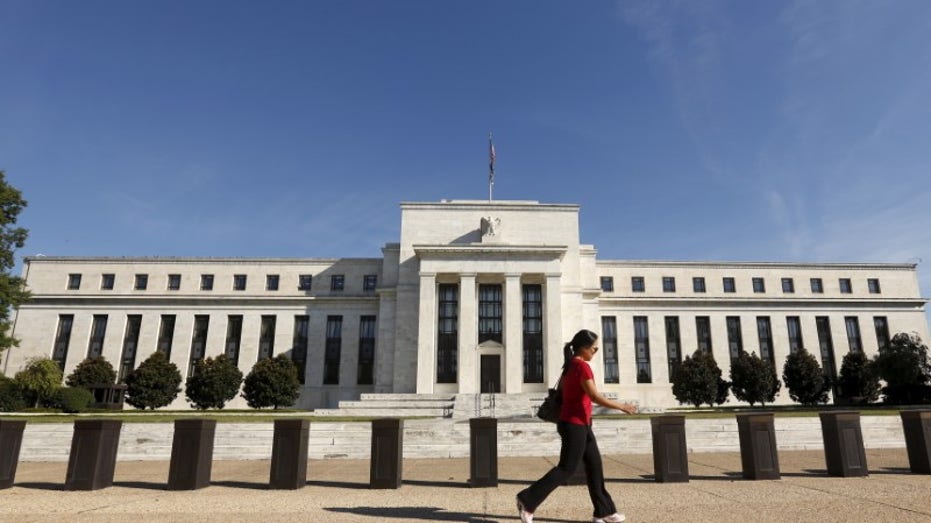Fed eyes faster interest rate liftoff, balance sheet reduction as inflation soars
US central bank on track to end its bond-buying program by March
Biden put the Fed in 'precarious spot': Expert
Kroll chief strategist Chris Campbell says government spending will force the Federal Reserve to raise interest rates.
Most Federal Reserve officials agreed last month that surging inflation and a rapidly recovering labor market could warrant a faster-than-expected interest rate hike as policymakers seek to wind down pandemic-era support for the U.S. economy.
| Ticker | Security | Last | Change | Change % |
|---|---|---|---|---|
| I:DJI | DOW JONES AVERAGES | 47951.85 | +65.88 | +0.14% |
| SP500 | S&P 500 | 6774.76 | +53.33 | +0.79% |
| I:COMP | NASDAQ COMPOSITE INDEX | 23006.360777 | +313.04 | +1.38% |
Minutes from the U.S. central bank's Dec. 14-15 meeting show that many policymakers believe they will reach their employment goal soon if economic conditions continue to improve, opening the door to the Fed's first interest rate hike in three years. The Fed slashed rates to near zero in March 2020 as the nation confronted an unprecedented pandemic that froze economic activity and plunged the country into its steepest recession in almost a century.
FED DOUBLES TAPER RATE, EYES THREE INTEREST RATE HIKES IN 2022
"Participants generally noted that, given their individual outlooks for the economy, the labor market and inflation, it may become warranted to increase the federal funds rate sooner or at a faster pace than participants had earlier anticipated," the minutes, released Wednesday, said. "Some participants also noted that it could be appropriate to begin to reduce the size of the Federal Reserve’s balance sheet relatively soon after beginning to raise the federal funds rate."
Stocks tumbled on the news.

In this March 3, 2020 file photo, Federal Reserve Chair Jerome Powell speaks during a news conference to discuss an announcement from the Federal Open Market Committee in Washington. (AP Photo/Jacquelyn Martin / AP Newsroom)
At the conclusion of their two-day meeting last month, policymakers announced they would double the tapering of a massive bond-buying program, putting the Fed on pace to end the program by March. In making the decision, they cited improvements in the labor market and the hottest inflation in nearly 40 years.
Although officials held rates near zero during the meeting, they were unanimous in forecasting at least one rate hike next year. That marked a considerable shift from September, when half of the central bankers believed interest rate increases were not warranted until at least 2023.
Officials now project rates to stand at 0.9% at the end of 2022, 1.6% at the end of 2023 and 2.1% at the end of 2024.
"We believe the Fed is likely to raise interest rates quicker and potentially shrinking their balance sheet sooner than many expect as they signal fighting inflation is more important than protecting against a drop in economic activity," said Chris Zaccarelli, chief investment officer for Independent Advisor Alliance. "What is harder to forecast is to what level of market selloff they are willing to tolerate before changing course."

A woman walks past the Federal Reserve headquarters in Washington Sept. 16, 2015. (REUTERS/Kevin Lamarque / Getty Images)
Traders expect the Fed to begin raising rates in March, according to the CME's FedWatch tool, which could mean the balance reduction begins in early summer. Policymakers said the appropriate timing of reducing the balance sheet would likely be "closer to that of policy rate liftoff in the committee’s previous experience," the minutes said.
Meeting minutes suggested that once the process begins, the runoff of the $8.8 trillion balance sheet could be "faster than it was during the previous normalization episode" in 2017. Some participants also "judged that a significant amount of balance sheet shrinkage could be appropriate over the normalization process."
CLICK HERE TO READ MORE ON FOX BUSINESS
For months, the Fed has been wrestling with its dual mandate of stable prices and full employment: The nation's jobless rate plunged to 4.2% in November, but there are still about 6.9 million out-of-work Americans. At the same time, consumer prices in November soared 6.8% from a year ago, the fastest pace since June 1982.





















